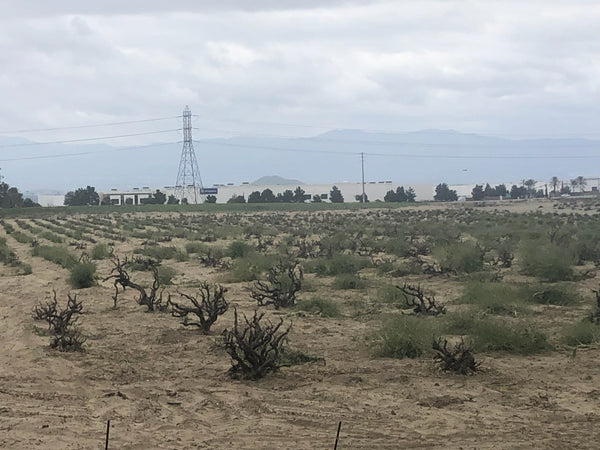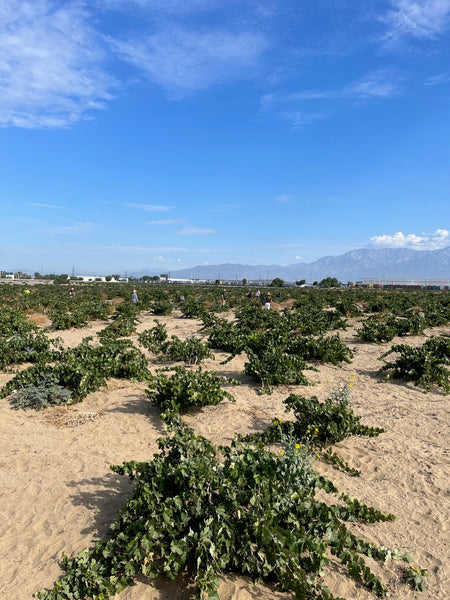Your cart is empty!
A Chat with Rajat Parr
"There used to be 40K acres, and now there’s something like 600 acres."

In LA's backyard, THE SCYTHIANS is a new project from Cali legends Rajat Parr and Abe Schoener. País, planted in 1896. Palomino and Zinfandel, planted in 1912. These may not be famous vineyard sites; but, they are some of the state's most historic.
Below: our Carolyn Negri caught up with Rajat this week on how this work is restoring the area's long tradition of viticulture, and where it's headed next.
Carolyn: So! How did this all begin.
Rajat: This was something Abe found; he moved to LA, and he wanted to make wine from these old vineyards. And then he had a dream: I was his partner in the project. So he called me…I was like Abe! I’m about to take on a whole new world and move further away north, I was transitioning to Cambria at the time [just NW of San Luis Obispo]. So I helped him with the ‘19, ‘20…and I was encouraging him to keep on doing this project. And then in ‘21, we found this Palomino vineyard, the Lopez vineyard. And he’s like – it’s a big vineyard; I can’t make all the wine! So I’m like yeah okay, I’m in, I’ll do something. And that’s how it started. We made I think 200 cases of Palomino , 200 cases of Scythian red, from Francis Road. That was the idea - make two wines, and we’re all good.
Then in comes [importer] José Pastor. José tastes the wine, he’s like - “This is amazing! You should make more wine!” I’m like José. There’s no way I can make more wine because I don’t have time to sell it. This is gonna need a lot of storytelling… this wine just happened, this is not like a wine region anyone’s heard of. They’ve been making wine here [for a long time] but for fine wine, it didn’t exist. He says - how about it we partner and we do it, I will help you. So he really pushed [it along]. We did the ‘22 vintage with very limited resources; in two tiny little rooms in downtown LA, and we made it work.

It sounds intense.
For me the most fascinating thing about these vineyards: here I am in Cambria trying to do regenerative farming, trying to minimize on the use of chemicals, trying to incorporate these principles; and here in Cucamonga, they live it! There are no sprays in the vineyard, the carbon footprint is...negative! In ‘21 there was no sulfur; ‘22 we used a little sulfur because it was a new cellar, the fermentation was happening very slowly. These vineyards have such an amazing story and history, and they need such little input. The families who own and manage them are trusting us to make the wine and tell the story.
I’m excited to do some other stuff and if all goes right, maybe make a little sparkling from Palomino. We’ll see how the fruit is, it just started to flower right now and we’re looking at a mid-August harvest. It’s good because in Cambria our harvest is in October.
I would love to drink some of that Palomino as sparkling. It’s so expressive and pretty, and has a lot of depth to it.
Yeah so we’ll hopefully do 3 or 4 different versions of it, including a sherry.
It feels like there’s a lot of authenticity in the location there, because it’s so off the beaten path; LA is a really populated place, but tucked east of there are these vineyards.
Around the vineyards are some office buildings, some freeways. There’s not a whole lot of population there. It’s really in the foothills of the San Bernardino mountains - just below Big Bear actually. Kind of a ski area - it’s kind of crazy. All these deep, sandy soils.

How did Abe come across it?
He drove around, visited some vineyards. We found the Lone Wolf vineyard, the old Mission - together with Christina Rasmussen in ‘19. In 60 years, it’s never been touched, until 2020. It was just by going there; me and Abe were always driving around checking out things. And then the pandemic happened.
Did that slow it down? Or could you work through it?
Definitely. Abe had rented a space to make the wine and have a tasting room, in 2019; and in 2020, he couldn’t use it. The business plan kind of had to change. I think he was bottling when the lockdown started - so he had to get permission from the police to bottle. I was supposed to be there and of course couldn’t make it. So everything changed after that.
I’m curious how you found yourself growing from project to project - if that was an organic transition? Or more intentional? It doesn’t sound like you were looking for a new project here…
No, I was definitely not! I was helping out Abe in the beginning and when I started to make my own wine, that was when the Scythian Wine Co. was formed. We have different winemaking styles; if you have my wine and Abe’s wine, there are many similarities and also many differences. We share the same vineyards, we pick at the same time, make the wine in the same place - but many other things are different.
I was struck by that – when I think about tasting other wine that you’ve made, especially say Domaine de la Côte. And then Scythians. There’s obviously a common thread of expressing really particular places in a beautiful way; but Scythians feels a lot less restrained, more purely wild.
It’s the place, and also where we made it. We made it in downtown LA in a place that never made wine before. We just bought some rails, put some barrels on them; we barely had a pump, we had a pump like, week two. We were bucketing over, pressing by hand, no sorting table, no destemmer. Just making wine in the wild. It’s the opposite - I think Sashi would laugh! He would definitely laugh if we saw how we made the wine. Versus Dom. de la Côte, where we have perfect tanks. Here we have completely dry farmed vineyards, with no irrigation, no sprays, it’s completely opposite of…any other wine I’ve made.
That’s what gives me even more hope and more confidence, that we’re gonna do better this year and onwards. We know that the vineyards are performing at this level in the hardest, driest year. That was a hard year, 2022; by any stretch of the imagination it wasn’t an easy vintage for anybody. Not only the growing season but the harvest - getting pickers was impossible, we had to harvest ourselves…I pick all of my own grapes in Cambria, too, but it’s a different experience. Driving the truck to downtown LA, parking outside, pitchfork it - there’s no machinery. It’s very visceral and raw winemaking.

It really does come through in the wine. I’m also curious, you mentioned some interesting history about the name - a common interest in history.
That’s a funny story. I forget what year it was - maybe 2016. I had known Abe a little bit, after an IPOB tasting late at night we ended up at Ten Bells. And at the time i was listening to a podcast about the Persian empire, by Dan Carlin - Hardcore History. They were talking about the Scythians. They were a nomadic warrior people in 500 BC who traveled and plundered and were rented as warriors; it was also the first time someone had referred to drinking, getting drunk: “drinking like a Scythian.” They drank fermented mare’s milk.
Now we are at Ten Bells, and we start talking about history. Abe was challenging me; he didn’t realize that I knew my history, and I was also a geek; I didn’t know he was teaching Greek philosophy. We kind of connected on the Scythians....And the reason it plays well with this project is that I live in Cambria, and during the harvest I come to LA, we make the wine, and I come back to Cambria. It’s like the Scythians, they were a nomadic tribe, they went from place to place and never set up shop.
We’re at a lot of inflection points as an industry - beyond what people think is “typical” - going beyond traditional places, traditional varieties; more balanced winemaking, whether that’s in the cellar or in labor practices. It feels basic to say that the wines are “on trend” or “of the moment” but they do feel really relevant in that way.
If we talk to the people of Cucamonga, they’re like, we’ve always been here, we haven’t changed what we do [organic, no irrigation]. They’ve done the same thing for 100+ years because the center of California wine was Los Angeles. It was not Napa, not Sonoma. If you look at the LA County logo, it has vines on top of it. Until 1905, 1910; vineyards were all over Pasadena and the east side of LA. Jean-Louis Vignes was making wine there in the 1700s.
To be honest, we lucked out that the wines are good. It seems a la mode, but it’s a la mode because it happened to be that way.

And your own history. I think for a lot of people your story begins in San Francisco, but you must have had an interest in food, in wine, before that.
I was born in Calcutta, and my family loved eating and drinking. From a young age, I was always around my mother, my grand mothers - food was the center of the conversation often times…Food was definitely what I was attracted to. And then I tried wine, and I said ok! This sounds more interesting. That was how it all started.
All the way from there, to a Cucamonga Revolution.
I’m just grateful for Abe to allow me in the space, and for José - without him, I don’t think I would be able to do it...we have José and his team to spread the word about Cucamonga, about this old place that is now being rediscovered. People don’t realize these vineyards are in jeopardy. Someone could just buy them and build an office complex. And that’s what happened; there used to be 40K acres, and now there’s something like 600 acres. I’m grateful that some of us can make wine from here and keep the vineyards intact.
One last thing: how would you describe the personality of the wines, in three words?
The wines are pure - that’s the fruit quality. Wild - that’s the exotic nature of the blends. And the wines have rusticity - that’s just the way it’s made, and where it’s made.
